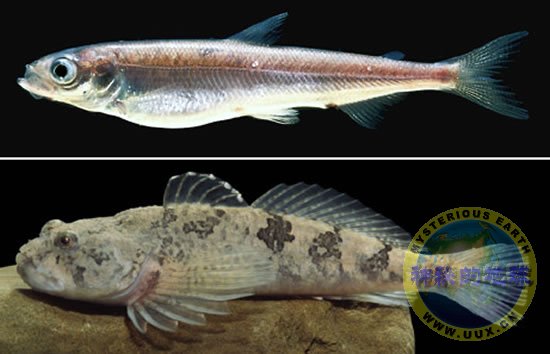57 New Freshwater Fish Species Found in Europe
The silvery pink Coregonus fontanae (top) and the mottled brown Cottus perifretum (bottom) are among 57 newfound species of European freshwater fish, scientists recently announced.
Photographs courtesy Jörg Freyhof
James Owen
for National Geographic News
November 14, 2007
Europe's rivers and lakes boast at least 57 more freshwater fish species than previously thought, scientists have announced.
The new species were discovered during a seven-year assessment of the conservation status of freshwater fish in Europe that was conducted in collaboration with the World Conservation Union (IUCN).
The findings lengthen Europe's list of freshwater fish to 522 species.
And the study authors say many more undescribed fish have been found or are suspected to exist, potentially taking the total number of confirmed species to 600 or higher.
"The new species come from all over" Europe, said co-author Jörg Freyhof of the Leibniz Institute of Freshwater Ecology and Inland Fisheries in Berlin, Germany.
Freyhof and co-author Maurice Kottelat from Cornol, Switzerland, present their data in the Handbook of European Freshwater Fishes.
Data from the handbook, which was released in early November, also determined that more than a third of Europe's 522 freshwater fish species are at risk of extinction and that 12 species are already extinct.
Close Scrutiny
The newly described species include the world's smallest known cisco—a type of whitefish—that was found in Germany's Lake Stechlin, north of Berlin.
The silvery pink fish, dubbed Coregonus fontanae, was found to be distinct from a much larger cisco species from the same lake.
Two new species of troutlike charr were discovered in alpine lakes in Germany and Switzerland.
The study team also named eight new sculpin, a type of small, squat river fish often found under stones.
One of these freshly named species, Cottus perifretum, had been labeled as another European sculpin, Cottus gobio.
Yet the two species are relatively easy to tell apart, according to Freyhof.
"The skin of Cottus gobio is very smooth, but perifretum's is like sandpaper," he said.
"There are many molecular markers which also distinguish the two species."
Harder to tell apart were members of a group of lake fish from Central and Eastern Europe called shemayas. But the study team was able to identify four new shemaya species.
"At first glance they appear like herrings—you really have to look at them in detail," Freyhof said.
"Shemayas have a wide distribution, but they are highly localized and are usually difficult to collect," he added.
"In the museum collections there are very few. Only after we checked almost all the populations in detail did we realize there are so many."
Getting Noticed
According to Freyhof, the new freshwater species might have remained undiscovered for so long because until now scientists had not compared fish closely enough across countries' boundaries.
For example, a newly discovered species of chub from Greece was long thought to be the same species as a chub living in Britain.
But the Grecian fish has black fins, while the British variety has orange fins.
"This color fades when the fish are preserved, so maybe a Greek scientist had seen a [British museum specimen] and so couldn't see it didn't have black fins," Freyhof said.
The new Greek fish, called Squalius orpheus, is one of five previously unrecognized chub species identified by researchers during their search.
"Once you realize a fish looks different, then you can go into more detail, analyzing its bones, scales, DNA, and so on," Freyhof added. "Then you realize, Oh, it really is different!"
Kevin Smith, of the IUCN Freshwater Biodiversity Unit, said that deciding which distinct fish merit species status can lead to lengthy scientific debate.
But the new species included in the handbook have been individually described in scientific journals, he noted.
They have also been added to the Catalog of Fishes, the leading global checklist of fish species, which is maintained by the California Academy of Sciences.
"Fish are a massive part of our fauna, but people don't tend to notice them because they are out of sight," Smith said.
Unlike free-ranging animals such as birds and mammals, fish are often isolated from each other because river basins and lakes act as barriers that keep unique populations apart, he said.
Moving fish between rivers or lakes through practices such as stocking for angling and commercial fishing therefore presents a serious conservation threat, he added.
"Drought is also a major threat, especially in the Mediterranean region," Smith said. "With the onset of climate change, rivers are starting to run dry in the summertime.
"Whether [the fish are] unique populations or you call them separate species, either way, once their river runs dry, they're not coming back."












